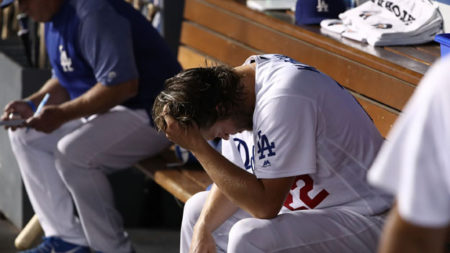Baseball’s Blue Plate Special Tastes Pretty Darn Bland
 When Baseball Got It Right
When Baseball Got It Right
Baseball got it right in April 1947 the moment Jackie Robinson and the Brooklyn Dodgers took the field against the Boston Braves before 25,000 fans at Ebbets Field. Branch Rickey’s bold decision to opt for inclusion changed baseball forever and greatly benefited the next two decades of championship play.
And yes, those baseball games featured mangers calling hit-and-run plays, an occasional sacrifice bunt by players other than a pitcher to move runners into scoring position and starting pitchers who threw complete games (not the five-inning outing that counts as a quality start in today’s game). Those games were about fundamentals and subtle ways of scoring runs, more than the brute power of today’s game. And even a thundering home run. Occasionally.
Best of all were the relentlessly exciting baseball games played in the 1950s that highlighted great rivalries, lots of small ball, by-the-book managing and, perhaps most important to the quality of play, team continuity. Players remained in organizations until they were either traded or released.
That’s because the Reserve Clause was still in effect. Cost continuity ruled the day. And as had been the case ever since the Reserve Clause had first been instituted (in 1879, as the “five-man” rule that allowed teams to designate five players they would retain each season), fans expected to see the same players on their favorite teams year after year, with the exception of an occasional trade. And they did.
Because under the Reserve Clause, teams retained the services of every player the year after their contracts expired (so in reality a team never lost control of a player once he signed his first contract).
So, with the lack of player movement and the introduction of new, exciting black and brown talent into the major leagues, baseball prospered in the 1950s and 1960s, getting it right.
Until Baseball Did not Get it Right
But as revenues increased and player salaries remained static (with a minimum rookie salary of $6,000 and an average annual player salary of $19,000 that had remained constant for years), player unrest grew. The Major League Baseball Players Association (MLBPA) decided to hire a labor attorney, Marvin Miller, as their new Executive Director in 1966, setting in motion some of the greatest changes in baseball history.
A clear sign that baseball had stopped getting it right by the early 1970s.
Another sign was Curt Flood’s legal challenge to the Reserve Clause that he and Miller took to the Supreme Court. Even though they lost, player dissatisfaction had gone public. A few years later, the Reserve Clause would be invalidated by an arbitrator (in 1975) and baseball would begin to careen out of financial control.
By 1982, when Marvin Miller stepped down as Executive Director of the MLBPA, the average player salary had risen to $241,000. Nope, baseball was no longer getting it right.
Of course, had ownership distributed more of its revenues to the players in the form of more generous salaries, ownership might not be spending hundreds of millions of dollars on salaries today.
But, short-sightedness, getting it wrong, doomed baseball to play a self-destructive escalating money game that forced its players to resort to legal actions to receive what they thought was a fair share of industry revenues.
Statistics, which had always formed the basis of player value, became the basis of salary disputes with each side interpreting statistics in such a way the numbers said what they wanted them to. And free agency monetized statistical values, showing players what ownership valued, and what they didn’t.
The effect of money was to canonize what players needed to achieve to make a lot of money. Players learned what they could get away with. Fewer sacrifice bunts. Fewer times moving the runner over. Or putting the ball in play. And of course, striking out more in pursuit of home runs. Players quickly figured out that they could still make millions of dollars even if they struck out 150 or 200 times a season. Attain “certain” numbers and you, too, can earn millions of dollars a year.
And Baseball Changed Forever …
Once free agency began, player costs went from minimal and predictable (for ownership) year to year to unpredictable. It was not only cost, but since contracts expired and had to be renewed at differential amounts, teams could no longer count on retaining certain players, since they could freely sign with another team. And nor could teams budget, since they had no idea what their precise player costs would be from season to season.
So, even though every manner of nationality is represented on the field today—from Australian, Canadian, Chinese, Cuban, Dominican, Dutch, Japanese, Korean, Panamanian, Puerto Rican and Venezuelan to American—the game has suffered because, despite a wide range of skills and talents, money has corrupted the intensity and dedication of players. So much so only some organizations seem to be able to compose a team of winning players.
Especially when every player seems to receive a healthy raise in guaranteed money, no matter how hard they play. No matter how well they perform. So, no player needs to produce the way players once did when their jobs were not guaranteed and only an outstanding season might guarantee a pay raise.
So, Baseball’s No Longer Getting it Right
There is a genuine lack of enthusiasm to sign outstanding players to expensive long-term guaranteed contracts that run five to 10 years.
Note the words long-term and guaranteed. When figures like $300 or $400 million dollars are attached to those contracts, ownership flinches. Even when the players are baseball young, which means 26 years of age in the case of Manny Machado and Bryce Harper—the two most recent examples of the dysfunctional baseball cookie cutter system. And while they may be excellent examples of the home-run hitting culture, it’s doubtful either player will ever prove to be a $300 million value. Especially when the money is guaranteed and it all must be paid.
Just look at Clayton Kershaw. Paid a fortune by the Dodgers, close to $35 million last season, he clearly was not worth that much money to the Dodgers this past season, especially in the playoffs when his performances were disappointing. But his numbers were guaranteed.
No baseball player is worth that much money, truth be told. And if they are valued at those numbers, it should be on a year-by-year basis, not five or 10 years.
Were this the NFL and a player was offered a 10-year contract worth $350 million, more than likely, only $100 million would be guaranteed. And, more than likely, both Harper and Machado would have signed their contracts by now. But this is baseball, not football.
Were this football, Kershaw would’ve been released, paid his guaranteed money, and no longer be a member of the Dodgers. Like Troy Tulowitzki, who was released by Toronto with more than $30 million remaining on his contract, a highly unusual decision, because Toronto is paying the guaranteed money remaining. So, all the New York Yankees have to do, since they signed Tulowitzki after Toronto released him, is pay him the major league minimum salary.
Guaranteed money is significant enough to command the attention of ownership. A $300 million commitment over 10 years is real money, even to billionaires. So, they’re unwilling to part with their capital just like that. Of course, it’s ownership’s fault they’re in this predicament. Had they treated the players fairly years ago, they might have gotten it right.
Baseball is now a business gone wrong. Tilt! And both sides are suffering.
Owners considering opening their checkbooks to sign a free agent have invariably seen other owners fork over big contracts to players who were closer to their age-30 seasons who could not live up to those long-term contracts.
The horror show of these contracts is when it’s clear they’ve become albatrosses around the necks of their baseball clubs, preventing them from investing in younger, more productive players until their bloated payrolls can be thinned. Which usually takes time. Years in some cases. Since no team will trade for a bad contract, unless two bad contracts are being exchanged.
Chris Davis and Jason Heyward signed expensive long-term deals with the Baltimore Orioles and Chicago Cubs, respectively, which either team would gladly unload for a bag of balls if another team would assume the full contract. Needless to say, there are no takers.
Baseball’s Blue Plate Special
Maybe the appropriate question is, why isn’t baseball getting it right anymore? Why isn’t baseball serving up appetizing fare?
Why is tonight’s blue plate special home-run hitters swatting mammoth home runs alongside strikeout artists who create crazy, wild swinging strikeouts. With lots of runs scored gravied over fatty meat?
Why not a crisply played ballgame?
Why is it, more often than not, the blue plate special is yesterday’s leftovers reheated in a different pot. More home runs, more strikeouts and more sloppy play stretched out over three hours?
Wouldn’t baseball rather offer thick, juicy sirloin steaks, not meatloaf and potatoes. But to do this, baseball needs new stars. Not more all-or-nothing, home-run hitters.
More players like Mookie Betts, who not only hit home runs but singles and doubles, too. Players who hit to the opposite field and play a fundamentally sound game. While he hits a lot of home runs, Aaron Judge is in this category. So are Francisco Lindor and Alex Bregman.
The question is, how can management reward exciting players who do not hit many home runs? How can management create new must-see baseball television? More hitters like Jose Altuve, and even Brandon Nimmo, who had a solid season in 2018.
No wonder the baseball meal has become stale.
Tasteless. Like a trip to McDonald’s for a tired Big Mac. Fans lose interest quickly and have too many other entertainment choices to wait for reheated fare.
It’s no longer 1950 with only one small television to enjoy in the household. So, baseball, let’s get it right again and begin serving nouvelle cuisine.

























